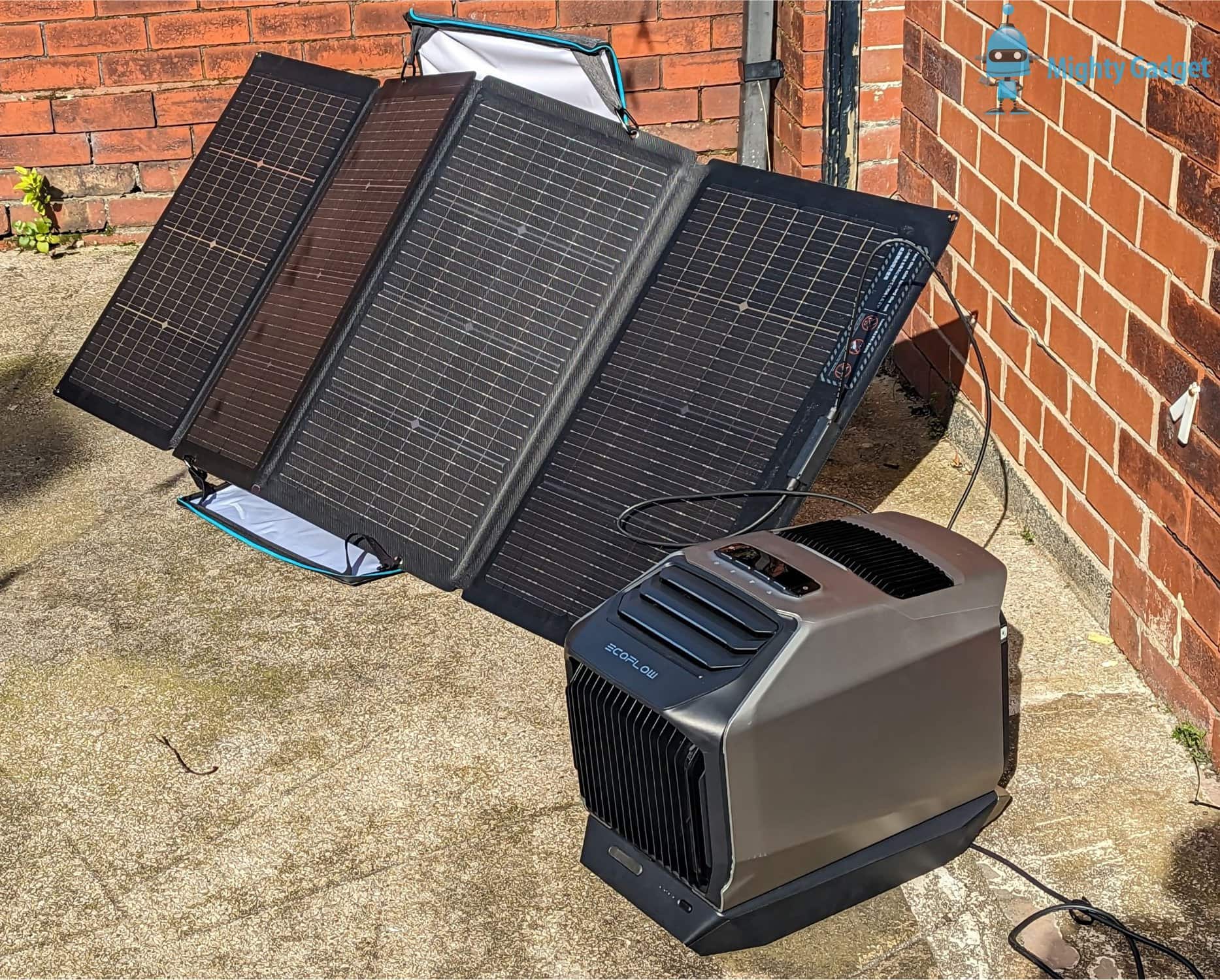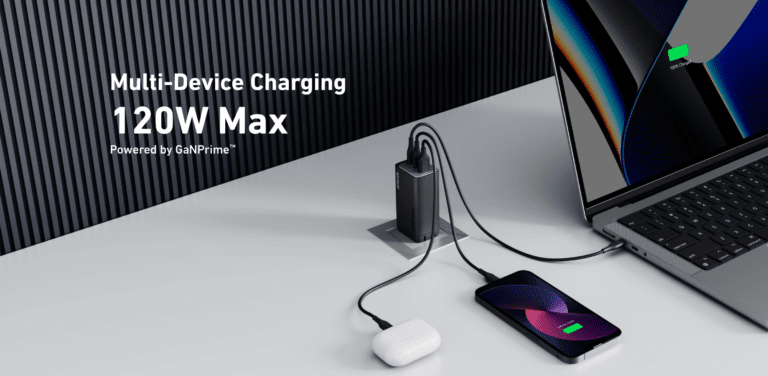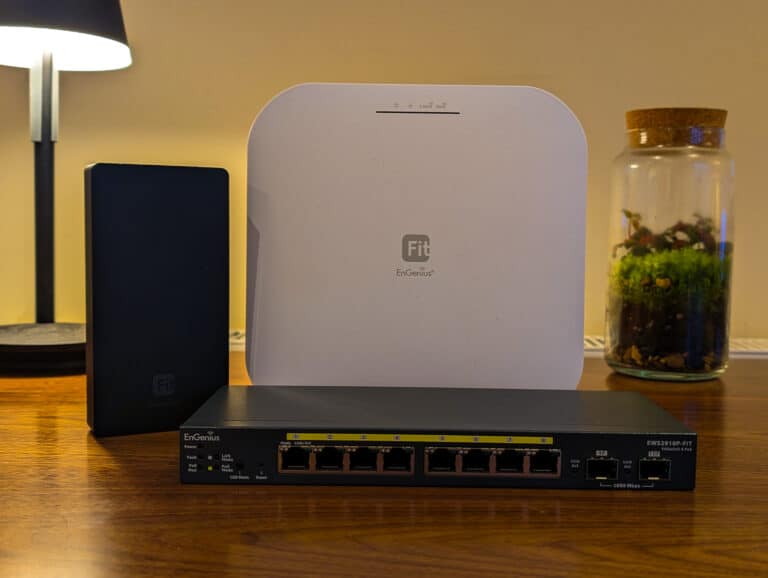Any links to online stores should be assumed to be affiliates. The company or PR agency provides all or most review samples. They have no control over my content, and I provide my honest opinion.
At CES 2022, EcoFlow announced they would launch the EcoFlow Glacier battery-powered portable fridge, Blade robot lawn mower and the Wave 2 portable AC and heater.
The Blade and Glacier have officially launched, and you can read my EcoFlow Glacier review here.
The EcoFlow Wave 2 will officially launch on 15th of May, and I have been testing it for the past couple of weeks.
EcoFlow Wave 2 vs EcoFlow Wave vs Zero Breeze Mark 2 vs Eenour QN750 Specification
| Portable Air Con Comparison | EcoFlow Wave 2 | EcoFlow Wave | Zero Breeze Mark 2 | Eenour QN750 |
|---|---|---|---|---|
| Cooling Capacity | 5100 BTU | 4000 BTU | 2300 BTU | 2900 BTU |
| Heating Capacity | 6100 BTU | N/A | N/A | N/A |
| Add On Battery | Yes | No | Yes | No |
| Weight without battery | 14.5 Kg | 17.5Kg | 7.5 Kg | 10 Kg |
| Noise Level | Eco mode: 48dB Sleeping mode: 52dB fast mode: 58dB | 55 dB | 52 dB | 58 dB |
| Price | £1,049/$1,299 no battery £1799 with battery | $1,499 | £1558.80/$1,499 with battery |
Features
- 6100 BTU heating and 5100 BTU cooling performance for vans, RV, tents, off-grid rooms, or outdoor spaces.
- Anywhere, anytime use: Weighs only 14.5kg without an add-on battery, making it more portable and compact.
- Anywhere, anytime recharge: can be recharged by AC/solar panel/car/power station.
- Up to 9.6h runtime while on Eco mode powered by an add-on battery of Wave 2.
- Installation-free and multiple accessory solutions
Design / Accessories / Battery
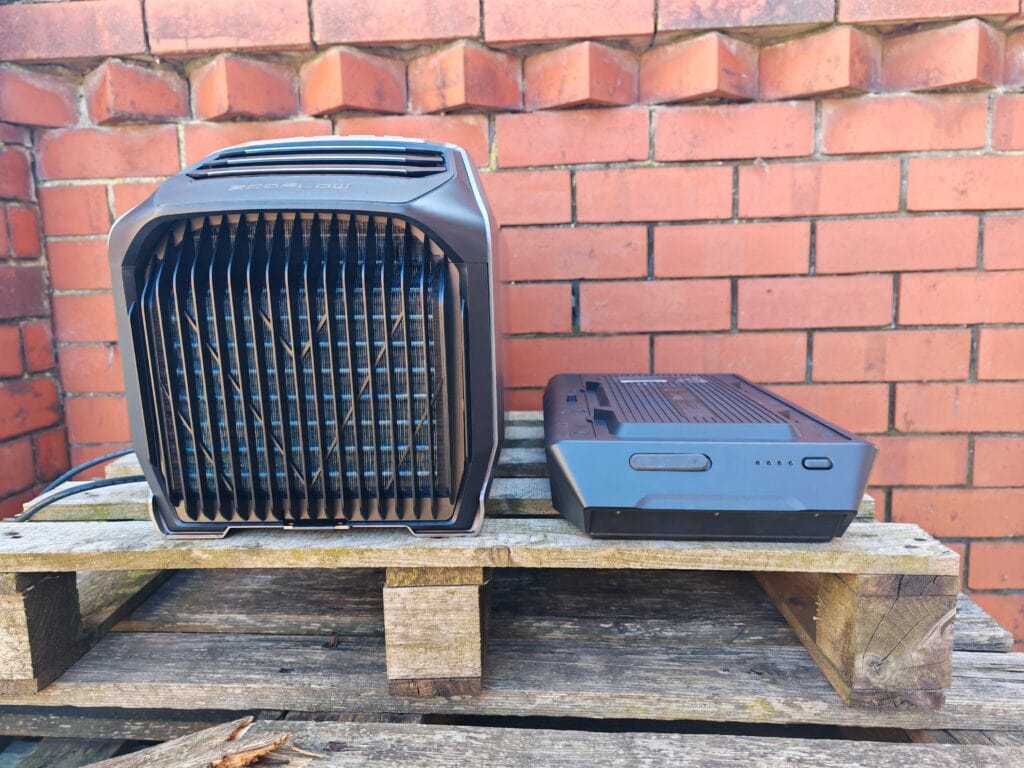
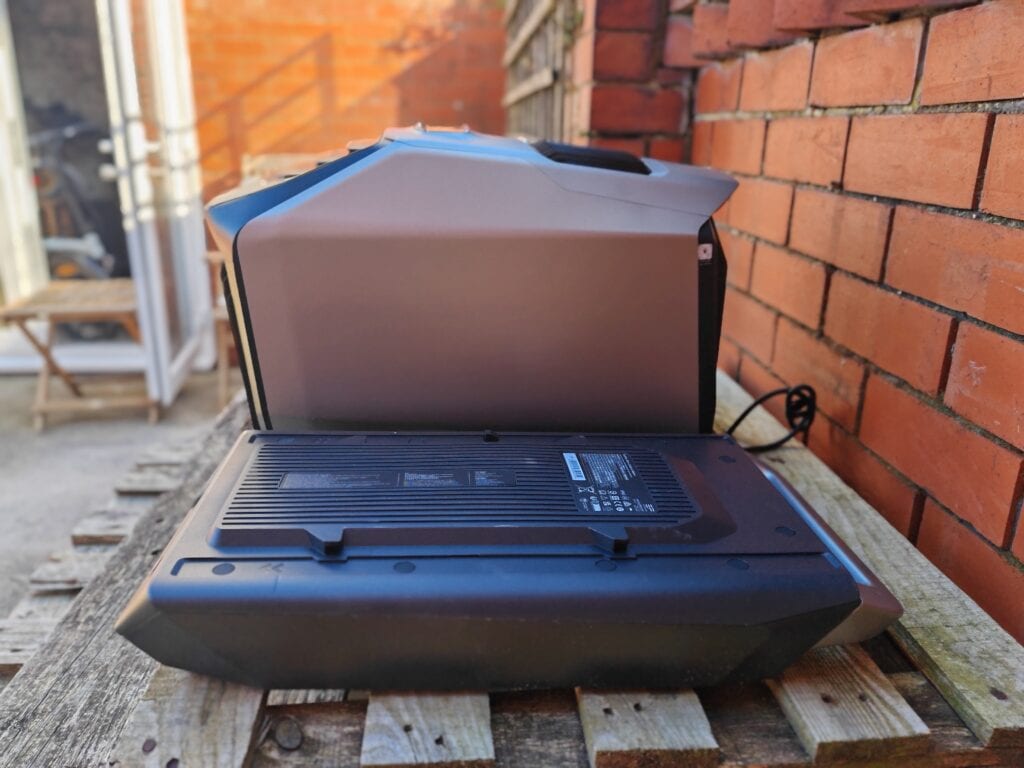
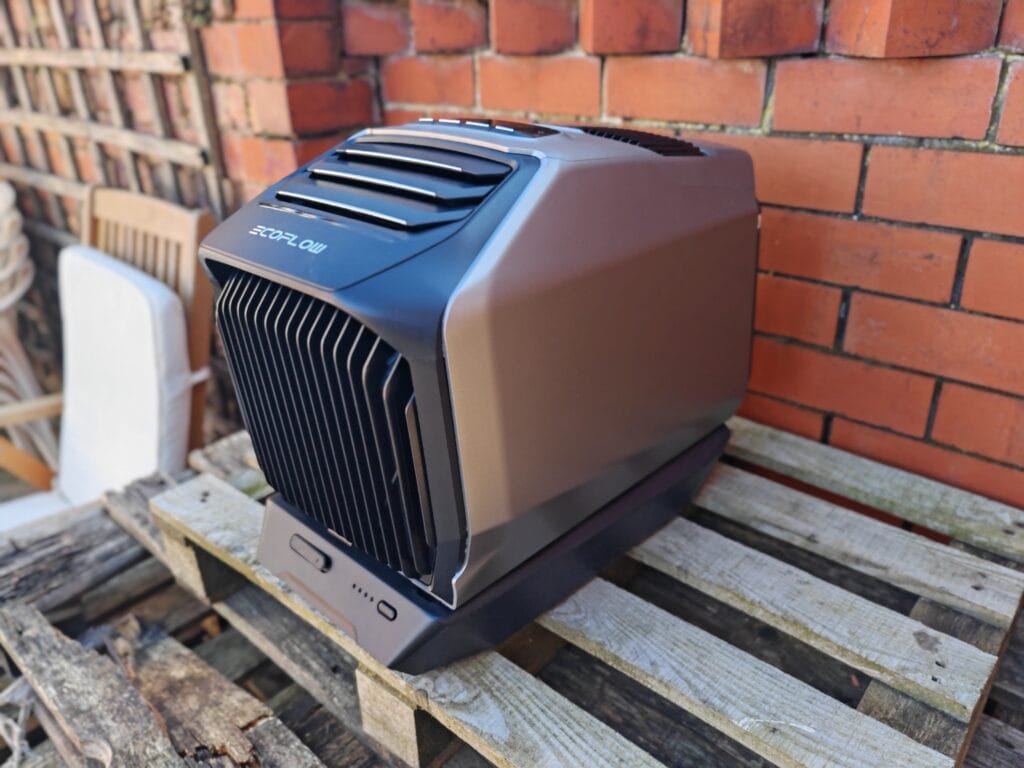
This is a tidy portable air conditioner, and this compact design is essential considering the target market. It shouldn’t get in the way when using it in confined spaces such as vehicles.
Ecoflow has somehow made it 3kg lighter than the EcoFlow Wave, and it has a carry-friendly design with overhanging sections on the top that make it easier to pick up.
It has quite an aggressive futuristic design, and initially, I was a little perplexed about how to set it up. Unlike normal air conditioning units, there are no obvious places to attach the venting tubes.
This is because the vents attach differently depending on how you use it. When you use the AC, you remove the grill on the rear and attach the mount, then the ventilation tube. There is a second mount that clips into the grills on the rear of the top of the AC.
The EcoFlow Wave 2 can run from a normal wall socket, but the big selling point is the optional add-on battery that allows you to run the air con unit for up to 9.6 hours in eco mode.
The battery has a capacity of 1159Wh capacity, and this also has 2x USB-A and 1x USB-C output ports, allowing you to charge laptops and phones.
This battery uses the NCM chemistry and is rated for 800 cycles before it hits 80%+ capacity. The battery is IPX5 rated. The battery will add an additional 7.5 Kg to the weight of the unit.
The battery slots onto the bottom of the AC and locks into place, which is then attached to the main unit with an included connector.
Unusually or EcoFlow products, this has a power cable built-in, and the AC unit is where you will find the XT60 port for solar or charging via car socket.
EcoFlow App
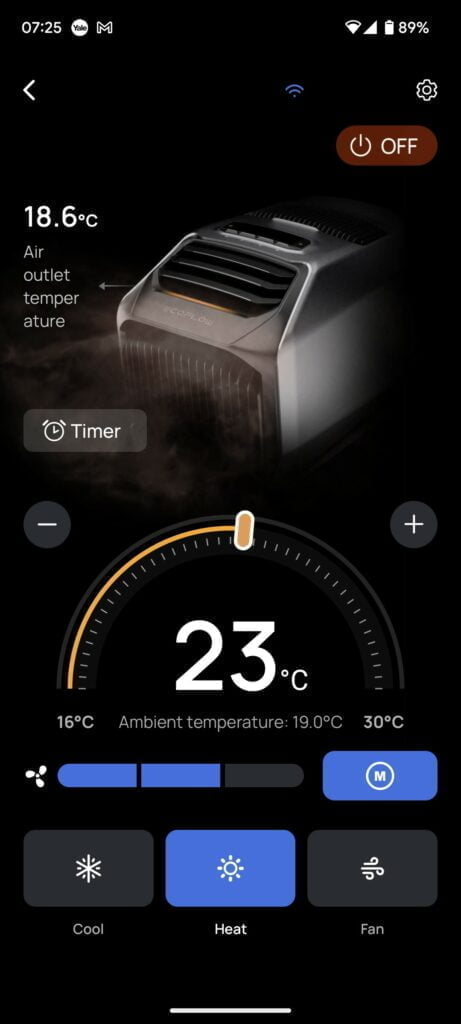
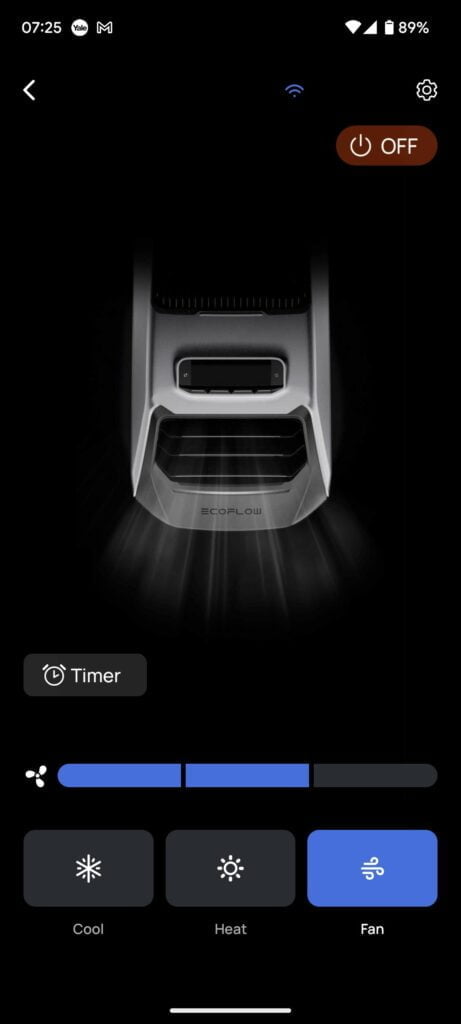
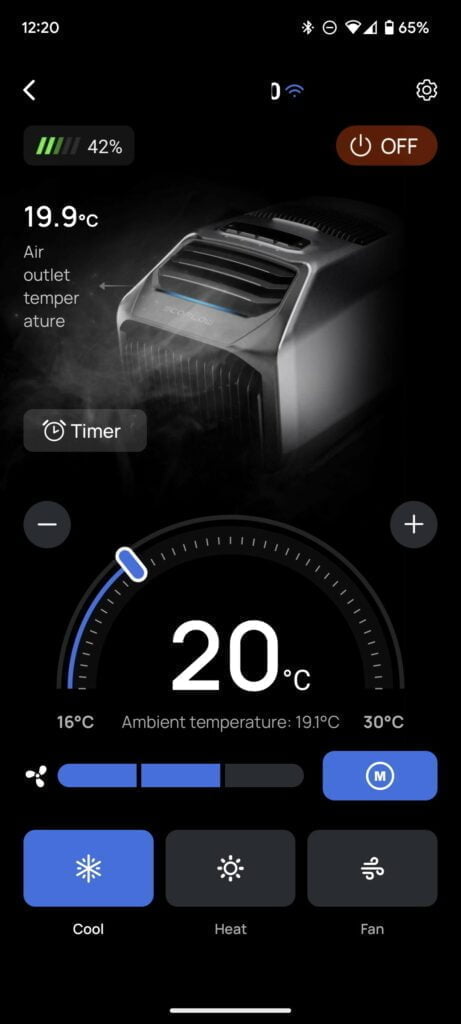
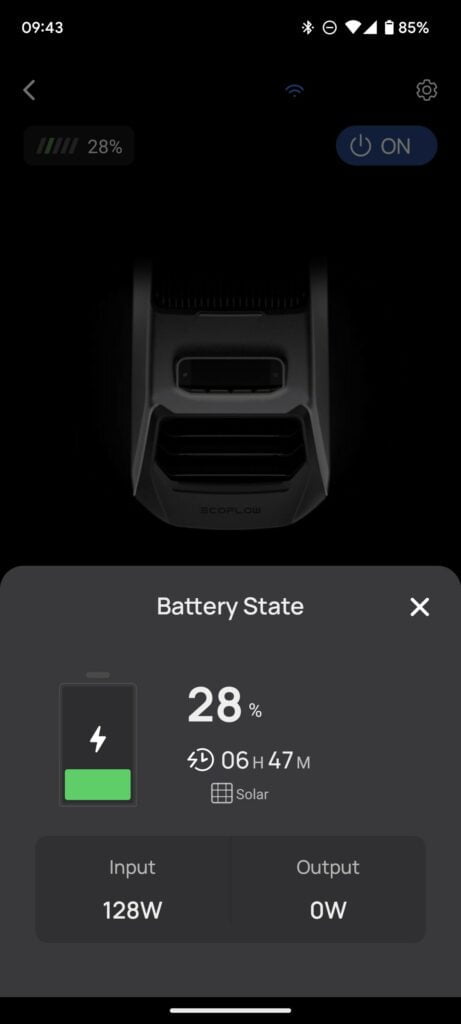
Like the other Ecoflow devices, this can be paired up with the Ecoflow app, and you can connect it to WiFi, allowing you to control it remotely.
I preferred to control the Wave 2 using the app because it is more user-friendly and intuitive. You have three main options, cooling, heating or fan only. You can then adjust the fan speed, set the temperature and set a timer.
The app will then report the temperature of the air it is expelling and the ambient air temperature of the room it is in.
Importantly, you can also see the battery percentage and if you click on the icon you will see the input and output.
There is not much to talk about within the settings menu, but you can update the firmware, and you may also want to set the drain function. You can have it in drain-free mode, where it collects the water and evaporates it into the room, or you can connect the hose and have it drain outside.
Solar and Mains Charging
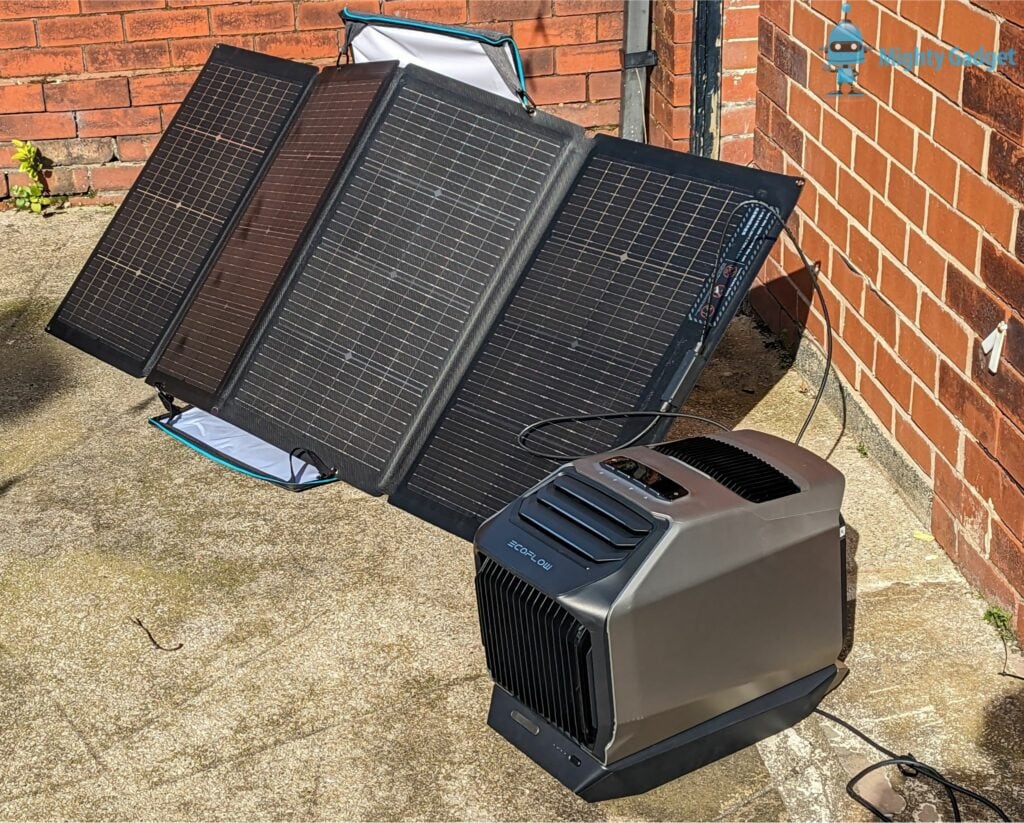
You have multiple power options:
- Wall Socket – up to 800W
- Portable Power Station – up to 800W
- Car Outlet via XT60 – up to 200W
- Solar Panel via XT60 – up to 400W
These all work with or without the battery, but you may struggle to run the AC properly if you try to use it solely from solar or the 200W XT60 car outlet.
I don’t have a boat/truck/RV to test this with, and I have not had the sample long enough to take it away camping (not that I really go camping).
Therefore I had to test everything at home and in sub-optimal conditions. I live in the north of the UK, and it’s the start of May when sunny spells are few and far between. My back garden is also quite small and eastern facing.
For solar charging, I tested this with the superb EcoFlow 220W bifacial solar panel. I did have some odd results, which could be related to the solar panel, the XT60 cable, or perhaps it is the Wave 2 either not charging properly or not reporting the charge rate properly.
I think I was using a third-party XT60 to MC4 cable, which is the possible culprit.
The app seemed to intermittently report that there was no charge. While it wasn’t the most sunny day, I’d expect to see some sort of input most of the time. When it did register a charge, I saw an input of up to 130W, which is well below what the panel is capable of but still quite good considering the sunlight exposure.
Cooling Performance
I tested this in my home, which isn’t really the target market, but it was the only option I had in the timeframe of this review. The Wave 2 has a cooling rating of 5100 BTU.
Most of my rooms are too large for this to be very effective, so I had I used it in our smallest bedroom. The room is approximately 2.5m wide, 4.5m long, and 2.5m height, and various AC BTU calculators suggest I need 5000 BTU, making the Wave 2 just about suitable.
I then had to make a makeshift window seal and vent. Our windows open from the bottom, so the normal AC window seals you can buy are not much use, and most of them also only have one vent hole.
Using my excellent DIY skills, I built a temporary seal using some thick cardboard and cut two holes for the vents. While my solution may be sub-optimal, I can’t imagine many people in RVs/boats/trucks having a perfect seal for venting. In the end, it worked well enough, and I won’t accept any criticism about it.
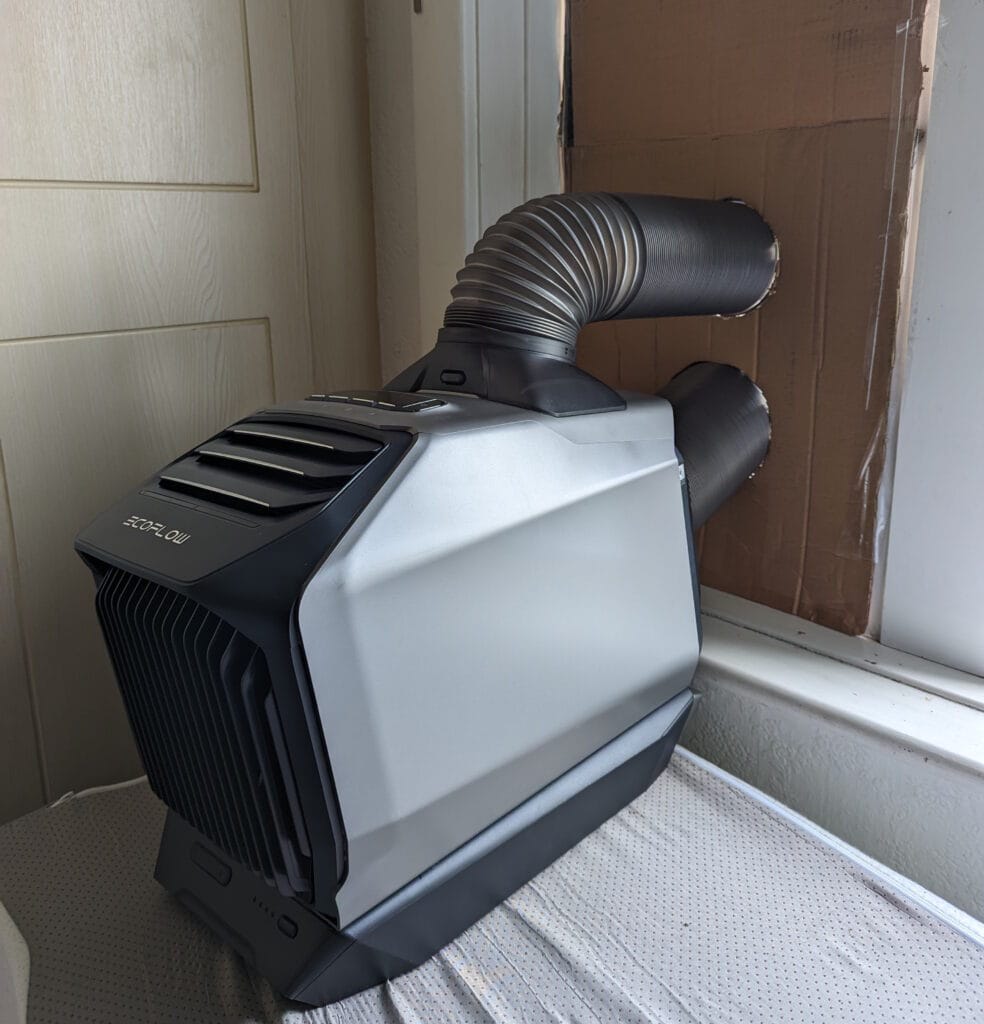
The dual vent design of this is unusual compared to most portable AC units sold in the UK.
Portable air conditioning units in the UK are almost always single hose where that pulls warm air from the room, then sends it past coils cooled by the refrigerant, and then sends the heated air and moisture through the hose and out of the house. This will likely cause negative air pressure and result in warm air being pulled back into the room.
The EcoWave 2 (at least according to the instruction diagram) draws in air from one hose, expels hot hair through the other and expels cold air through the front fans. This should make it much more efficient.
Cooling Performance When Using the Battery
As this was the start of May, the starting ambient temperature wasn’t very high. The Ecoflow reported 20°C, while my Airthings View Plus reported 21°C, which I had placed on the bed in the middle of the room. I also had a dumb temperate/humidity monitor, which reported 0.5°C below the Airthings.
I then set the cooling to the lowest temp of 16°C.
I ran it from the battery at first, which was at 43% when I started it at 12:13 pm.
At 12:38 pm, the battery had declined to 34%, and the Ecoflow app reported an ambient temperature of 15.5°C. Airthings reported 18°C.
At 1:11 pm, the battery had declined to 18%, and Ecoflow reported the temperature as 15.5°C, and Airthings said 17°C.
At 1:43 pm, the battery was nearly flat at 1%, and EcoFlow reported 14.9°C, with Airthings saying 16.5°C.
I then unplugged the battery and plugged the AC into the mains. I ended up accidentally leaving it running until 6 pm. Airthings appeared to report it hitting 16°C target temperature at about 3 pm, and it maintained this temperature until io switched it off (it dropped to 15.7°C at the lowest).
I didn’t drain the unit outdoors, so during use, the humidity levels increased from 40% to 50%.
Heating Performance
Similar to my cooling testing, the time of year is not ideal. My room temperature sits at around 20°C, which is hot enough already. However, I dialled up the heating to 23°C to see how it would perform.
This will vent cool air out of the top rear vent, so you will still want to keep the unit hooked up to the venting tubes.
It will allow you to see the heat up to 30°C, which seems excessively high for anyone’s needs.
Once it gets running, the app shows the air outlet temperature quickly rises to about 48°C.
The ambient air temperature rises quickly, and it recorded a 2°C rise within a few minutes. Within 20 minutes, the app was registering the ambient temperature as 23°C, but my temperature sensors in the middle of the room took quite a lot longer to show the target temperature.
Fan Noise
For cooling, I was very impressed with the noise levels of the Wave 2. My experience with portable AC units has only been for larger devices with a higher BTU, and as a result, they are annoyingly loud. Even with the sleep mode settings, they are all too loud for my liking.
I am a very light sleeper, so I still probably couldn’t sleep with this running, but the noise isn’t too intrusive, I could leave it running in my office at the normal fan speed setting without it annoying me.
The quality of the sound is good too. It is a consistent woosh with a low to mid-frequency. That may sound like an odd compliment for an air con, but inconsistent or high-pitched sounds can be very distracting for me.
For heating, the fan noise was less pleasant, it was somehow more high-pitched, and there was a bit of a squeaking noise. The noise did seem to improve over time, so I think it is just the initial heat-up process where it is a bit annoying.
Battery Life & Power Delivery Output
The battery has a capacity of 1159Wh, and EcoFlow state you can get up to 9.6 hours in eco mode.
This has three modes, and the official figures for power usage and run-time are:
- Fast mode – 500W Approx 2.3H
- Sleeping mode – 200W Approx 5.8H
- Eco mode – 120W Approx 9.6H
I used it in the normal performance mode, and I saw the unit pull up to 325W when I plugged it into the mains and ran it that way. I suspect the lower power draw was because the room was already getting close to the target temperature and therefore didn’t need to run at full power.
In my scenario, you should get around 3.5 hours of cooling.
If you are camping and you have good sun exposure, you should be able to run this via solar in Eco mode quite easily without discharging the battery. This could be an incredibly useful scenario as it you can avoid your accommodation warming up too much during the day.
For heating, this started out at around 300W but then increased to around 425W.
The battery also has USB ports and can do 100W power delivery via the USB-C port.
Power Usage & Electricity Running Costs
When I switched the air con over to mains power, I also used a power meter to monitor the power it used. As the room was already close to the target temperature, it was possible the power draw had been dialled back, but this pulled 325W when I initially plugged it in. When I unplugged it in the evening, it was pulling around 250W. The room was definitely at the target temperature then, so there was less need for cooling.
When I reviewed the Inventor Magic 12000 BTU portable AC, which had a rating of up to 1350W with an average draw of 1200W when I used it. That is more than double the cooling performance, and I used it when it was much hotter, so increased power usage is expected.
Price and Alternative Products
The EcoFlow Wave 2 will be available for purchase from the 15th of May. It will retail for £1,049 and will be available with a 1159Wh add-on battery, which will retail separately for £799. Both products can be bought together for £1799.
In the US, the EcoFlow Wave 2 will be sold for $1,299, and the battery is $899.
The original EcoFlow Wave didn’t launch in the UK and lacked a battery. This is sold in the US for $1,499.
The Zero Breeze Mark 2 Plus with battery kit is available in the UK for £1558.80. It has half the cooling capacity and is significantly louder. In the US, this is sold for $1,499.
In the UK, you get single-hose portable air con units such as the Amcor 7000 BTU for as little as £200, but this has a power draw of 880W, weighs 21kg and generates much more noise, so it is not really practical for the people that EcoFlow is targeting with the Wave 2.
Overall
For a start, I love how EcoFlow has taken their expertise in portable power stations and applied them to new products. They don’t seem to be scared of trying something a little different, and they are not messing around, either. They haven’t launched some half-arsed products; instead, they went with high-end premium solutions.
The EcoFlow Wave 2 is an exceptionally impressive piece of tech. My only experience with portable air conditioners is the large, loud and inefficient units that are popular in the UK for the 2 to 4 weeks heatwave we have each summer. This is in a completely different league.
While I didn’t use the Wave 2 in the environment it was designed for, it performed incredibly well. It is quiet, energy efficient (as far as an AC can be), and the cooling performance is impressive.
Due to the high price, I am not going to recommend this to everyone. However, for those people that do spend a lot of time living in off-grid environments and in compact spaces, then this is by far the best solution out there. The Zero Breeze Mark 2 Plus seems to be the only competing product, and it is not that much cheaper but has much lower performance.
Originally posted on mightygadget.com – Follow on Twitter – Instagram – Facebook – Mighty Gadget Latest Reviews
EcoFlow Wave 2 Portable AC Review Rating
Summary
The EcoFlow Wave 2 is an exceptionally impressive piece of tech that appears to be unrivalled. It performed incredibly well. It is quiet, energy efficient (as far as an AC can be), and the cooling performance is impressive.
Overall
90%-
Overall - 90%90%
Pros
- Best performance AC on the market for vans/campers/off-grid
- Battery run on eco for over 9 hours
- Solar charging
Cons
- Expensive
I am James, a UK-based tech enthusiast and the Editor and Owner of Mighty Gadget, which I’ve proudly run since 2007. Passionate about all things technology, my expertise spans from computers and networking to mobile, wearables, and smart home devices.
As a fitness fanatic who loves running and cycling, I also have a keen interest in fitness-related technology, and I take every opportunity to cover this niche on my blog. My diverse interests allow me to bring a unique perspective to tech blogging, merging lifestyle, fitness, and the latest tech trends.
In my academic pursuits, I earned a BSc in Information Systems Design from UCLAN, before advancing my learning with a Master’s Degree in Computing. This advanced study also included Cisco CCNA accreditation, further demonstrating my commitment to understanding and staying ahead of the technology curve.
I’m proud to share that Vuelio has consistently ranked Mighty Gadget as one of the top technology blogs in the UK. With my dedication to technology and drive to share my insights, I aim to continue providing my readers with engaging and informative content.

